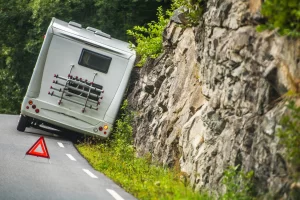For recreational vehicle (RV) owners, the promise of the open road with all the comforts of a mobile home can be enchanting. However, this promise comes with the responsibility of ensuring that your RV is packed with fun and essentials and well-prepared to handle the twists and turns of various terrains.
One crucial aspect of RV preparation that’s often overlooked is weight distribution. This guide will explain why it’s important and how to achieve the perfect balance for a safer and smoother adventure.
Understanding Why Weight Distribution Matters
Weight distribution refers to how the load in your RV is spread across the axles and tires. In simple terms, it’s about where the weight sits inside your vehicle. Here’s why you should care about it:
Safety on the Road
An RV that’s improperly loaded can lead to tipping or swaying on the road, especially when taking sharp turns or navigating high winds. Properly distributed weight ensures that your RV’s center of gravity remains stable, reducing the risk of accidents. It also helps with braking and steering, making your drive safer and more controlled.
Protecting Your RV’s Components
Excessive weight on one side of the RV can strain its tires, suspension, and other important components unnecessarily. Over time, this can lead to uneven wear and tear, causing costly repairs or replacements. Proper weight distribution helps distribute the load evenly, reducing the strain on your RV’s components and extending their lifespan.
Meeting Legal Requirements
In most states, there are laws that regulate the weight distribution of vehicles, including RVs. These laws aim to prevent accidents caused by overloaded or improperly loaded vehicles. As an RV owner, it’s your responsibility to ensure that your vehicle meets these legal requirements for safe and legal driving.
Minimizing Wear and Tear on the RV
An uneven distribution of weight can put excess strain on certain parts of the vehicle, leading to premature wear. This includes the suspension, axles, tires, and even the chassis. In the long run, this can be costly and cause road breakdowns. Proper weight distribution helps to distribute the load evenly, reducing wear and tear on your RV’s components.
Enhancing Driving Stability and Control

Balanced weight means better handling. It allows you to maintain control, whether on a straight highway or maneuvering through the mountains. This is especially important for larger RVs, which can be more challenging to navigate. Proper weight distribution also reduces the risk of swaying or fishtailing, making your drive smoother and more enjoyable.
How to Achieve and Maintain Proper Weight Distribution
To enjoy your RVing experience to the fullest and ensure you’re always the proper weight, follow these guidelines:
Weighing Your RV
The first step to achieving proper weight distribution is knowing the current weight. Drive your RV to a public scale and get accurate measurements of the entire vehicle and each axle with all your typical gear onboard. Ensure you have at least 10% of your RV’s overall weight on your hitch when towing to maintain proper towing capability.
Taking your RV to a certified weigh station annually or whenever you make significant changes in weight distribution is also recommended.
Distribute Weight Evenly
Remember to distribute the load evenly on each side and axle when packing your RV. Don’t overpack one side or the back of the vehicle while leaving the front empty. Use cabinets and storage compartments wisely to balance weight throughout the interior space.
If you’re towing a trailer, ensure the weight is evenly distributed on the axles and not overly concentrated at the front or back.
Don’t Exceed Weight Limits
Every RV has specific weight limits for its tires, axles, and overall vehicle weight. It’s essential to be aware of these limitations and never exceed them. Overloading can cause severe damage to your RV and put you at risk on the road. Maintaining proper weight distribution allows you to stay within these limits and enjoy a safe and hassle-free journey.
Use Weight Distribution Hitches
Weight distribution hitches are designed to distribute the load evenly between your tow vehicle and RV. They work by transferring tongue weight from your vehicle’s rear to the front, creating a more balanced weight distribution. This helps with handling, braking, and stability while towing.
Using Leveling Systems
Leveling your RV is not just about comfort; it’s about safety. A leveling system will help distribute the weight evenly across all tires, improving road grip and reducing the risk of skidding. A level RV also ensures that your appliances and cabinets are safe from damage due to uneven weight distribution.
Adjusting Tire Pressure
Under-inflated or over-inflated tires can wear unevenly and decrease handling. Use the tire pressure level your RV manufacturer recommends, as it’s calculated with proper weight distribution in mind. Regular maintenance ensures that your tires are always at the recommended pressure for a smoother and safer ride.
Tips for Maintaining Proper Weight Distribution
Here are some additional tips for keeping your weight distribution in check:
- Regularly declutter and reorganize your RV: Get rid of items you no longer need and find more innovative ways to distribute weight. If you’re a full-time RVer, make decluttering and reorganizing part of your regular routine.
- Balance water tanks: If you carry large quantities of water in your RV’s fresh water tank, ensure it’s evenly distributed on both sides.
- Check for weight imbalances during travel: Take note if one side is lower than the other while driving, as it may indicate an imbalance in weight distribution.
- Monitor tire wear: Uneven tire wear can signal weight distribution issues. If you notice excessive or uneven tread wear, have your RV inspected by a professional.
- Know your cargo weight: Always keep track of how much cargo you’re carrying and distribute it evenly throughout the vehicle. Avoid overloading one side or the back.
- Get professional help: If you’re unsure about the weight distribution in your RV, consider getting professional assistance. A certified RV technician can assess and adjust your vehicle’s weight distribution for optimal performance and safety.
- Consider the location of heavy items: If possible, place heavier items over your axles rather than the front or back of the RV.
- Keep an eye on water tanks: Don’t fill them unnecessarily to avoid excess weight when traveling.
- Be mindful of propane tank usage: Propane tanks can add to your RV’s weight, so don’t fill them unnecessarily.
- Keep tabs on the weight of additional passengers and pets: Make sure their combined weight doesn’t exceed your vehicle’s capacity.
- Regular Checks: Weight limits on your RV can vary by make and model, always check with your manufacturer’s guidelines and keep an eye on your weight distribution as your cargo changes.
- Packing Essentials Smartly: Place heavy items low and toward the center of your RV, to prevent them from shifting and affecting your center of gravity during travel.
- Seeking Professional Help: If you’re unsure about the weight distribution in your RV, it’s always best to seek the help of a professional. They can provide personalized advice and recommend adjustments based on your specific model.
By following these guidelines and taking the necessary precautions, you can ensure that your RV is safe for the road and lasts longer with proper weight distribution. Remember, it’s better to be safe than sorry when it comes to your safety, your passengers, and others’ safety on the road.
What are the Dangers of an Improperly Weighted RV?

An improperly weighted RV can pose various dangers to the driver and other vehicles on the road. These dangers include:
Poor handling and control
An unbalanced RV can lead to poor handling and difficulty controlling the vehicle. This can be especially dangerous when driving at high speeds or in adverse weather conditions. Difficulty steering, braking, and staying in your lane are all potential consequences of improper weight distribution.
Increased risk of tire blowouts
Uneven weight distribution can cause excessive strain on tires, leading to uneven wear and an increased risk of blowouts. This can be extremely dangerous, especially when driving on highways or in remote areas with limited repair facilities. As tire blowouts can cause sudden and severe loss of control, it’s crucial to maintain proper weight distribution to avoid this risk.
Overworking the engine
An overloaded RV puts additional strain on the engine, transmission, and other mechanical components. This can lead to overheating and increased wear and tear, which could result in costly repairs or even vehicle breakdowns while on the road. Overworking the engine can also impact fuel efficiency, increasing your overall travel expenses.
Reduced safety in case of accidents
An improperly weighted RV can have more severe consequences in the unfortunate event of an accident. The unbalanced weight distribution can affect the vehicle’s stability and make it more susceptible to rollovers or jackknifing. It can also cause damage to the RV’s structure and potentially harm passengers inside. Proper weight distribution can help minimize the damage and keep everyone safe if you’re involved in an accident.
Reduced fuel efficiency
When an RV is overweight, it requires more power to move, leading to reduced fuel efficiency. Not only does this strain your vehicle’s engine, but it also increases the cost of your trip due to frequent stops for fuel. More extensive and heavier RVs are also more challenging to maneuver and park, making it a less enjoyable experience for the driver.
Damage to appliances and infrastructure
Improper weight distribution can cause damage to your RV’s appliances, cabinets, and overall infrastructure. This not only adds to repair costs but also puts you at risk of accidents or breakdowns on the road. As the weight shifts during travel, it can cause damage to the interior of your RV, making it uncomfortable or unsafe for passengers.
Structural damage to the RV
An overloaded or improperly weighted RV can cause structural damage, leading to costly repairs and potential safety hazards. This includes damage to the frame, suspension, and axles, which are crucial components of any RV. By maintaining proper weight distribution, you can avoid these structural damages and ensure the longevity of your vehicle.
Risk of legal consequences
Driving an overweight RV is not only dangerous but also illegal in many states. If you’re caught with an overloaded or improperly weighted vehicle, you may face fines and penalties, adding unnecessary stress to your trip.
Proper weight distribution is essential for your RV’s safety, performance, and longevity. Remember to regularly check your vehicle’s weight limits and distribute the load evenly between each side and axle. Utilize tools such as weight distribution hitches, leveling systems, and proper tire pressure to maintain a balanced RV.
Safe RV Travel
Your RV’s weight distribution isn’t just about being compliant with the laws; it’s about keeping yourself, your passengers, and other road users safe. It’s also about ensuring that your investment in your RV lasts for years to come. By following the steps outlined in this guide, you can confidently hit the road, knowing that you’re setting off on a properly balanced adventure.
Remember, the allure of the travel lifestyle is about more than the miles you put behind you; it’s also about the peace of mind that comes with practical preparation. Whether it’s your first trip or your hundredth, taking heed of this advice will enhance not just the comfort of your travel but also your safety and the longevity of your RV. Happy and balanced RV-ing!

